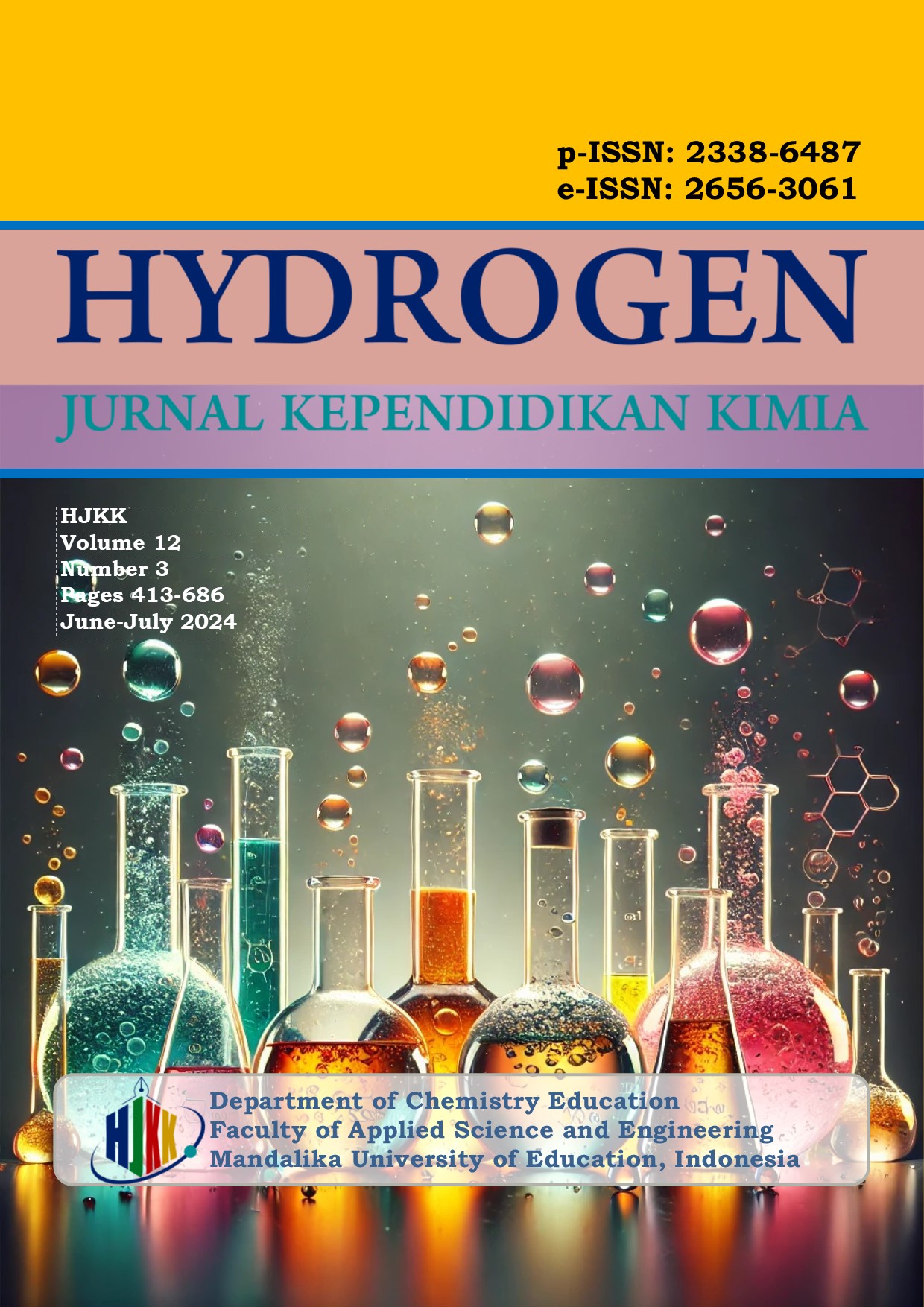The Effectiveness of Interactive E-Modules as Learning Media to Train Visual Spatial Intelligence in Chemical Bond Material
DOI:
https://doi.org/10.33394/hjkk.v12i3.8940Abstract
References
Agustina, A. (2017). PEMBELAJARAN KONSEP IKATAN KIMIA DENGAN ANIMASI TERINTEGRASI LCD PROJECTOR LAYAR SENTUH (LOW COST MULTI TOUCH WHITE BOARD. JTK (Jurnal Tadris Kimiya), 1(1), 8–13. https://doi.org/10.15575/jta.v1i1.1163
Azizah Mashami, R., & Andayani, Y. (2014). PENGARUH MEDIA ANIMASI SUBMIKROSKOPIK TERHADAP PENINGKATAN KEMAMPUAN REPRESENTASI SISWA. In Hydrogen (Vol. 2, Issue 1).
Buthelezi. (2013). Chemistry: Matter and Change. Glencoe/McGraw- Hill.
Davidowitz, B., & Chittleborough, G. (2009). Linking the Macroscopic and Sub-microscopic Levels: Diagrams (pp. 169–191). https://doi.org/10.1007/978-1-4020-8872-8_9
Deborah L. Carlisle. (2014). Developing Spatial Reasionning Skill in General Chemistry Students [Chemistry Education Research and Practice]. University of Massachusetts.
Hulu, G., & Dwiningsih, K. (2021). Efektivitas LKPD Berbasis Blended Learning Berbantuan Multimedia Interaktif untuk Melatih Visual Spasial Peserta Didik. Edukasi: Jurnal Pendidikan, 19(2), 319. https://doi.org/10.31571/edukasi.v19i2.2953
Ilyasa, D. G., & Dwiningsih, K. (2020). THE VALIDITY OF INTERACTIVE MULTIMEDIA ON IONIC BOND MATERIAL. JCER (Journal of Chemistry Education Research), 3(2), 51. https://doi.org/10.26740/jcer.v3n2.p51-57
Johnstone, A. H. (2006). Chemical education research in Glasgow in perspective. Chem. Educ. Res. Pract., 7(2), 49–63. https://doi.org/10.1039/B5RP90021B
Khery, Y. (2014). SOMATIS AUDITORI VISUAL INTELEKTUAL (SAVI). In Hydrogen (Vol. 2, Issue 1).
Korakakis, G., Pavlatou, E. A., Palyvos, J. A., & Spyrellis, N. (2009). 3D visualization types in multimedia applications for science learning: A case study for 8th grade students in Greece. Computers & Education, 52(2), 390–401. https://doi.org/10.1016/j.compedu.2008.09.011
Nismalasari, Santiani, & Mukhlis Rohmadi. (2016). Penerapan Model Pembelajaran Learning Cycle Terhadap Keterampilan Proses Sains dan Hasil Belajar Siswa pada Pokok bahasan Getaran Harmonis. Edusains, 4(3), 74–94.
Nur Huda, & Kusumawati Dwiningsih. (2021). Development of a Moodle-Based WordPress-Based Chemistry Learning Website to Improve Students’ Learning Outcomes on The Elements Periodic System Material. Jurnal Pendidikan Dan Pembelajaran Kimia (JPPK), 10(3), 67–76.
Peter Atkins, & Julio de Paula. (2006). Physical Chemistry (W. H. Freeman and Company, Ed.; 8th ed.). Oxford University Press.
Richard R. Hake. (1999). Analyzing Change/Gain Scores. Dept of Physics Indiana.
Rosmiati. (2022). Fun Chemical Learning in Madrasah. Uniqbu Journal of Exact Sciences (UJES), 3(1), 2723–3669.
Sanjaya Mishra, & Ramesh C. Sharma. (2015). Interactive Multimedia in Education and Training (S. Mishra & R. C. Sharma, Eds.). IGI Global. https://doi.org/10.4018/978-1-59140-393-7
Sugiyono. (2016). Metode Penelitian Kuantitatif Kualitatif dan R&D. Alfabeta.
Tjeerd Plomp, & Nienke Nieveen. (2013). Educational Design Research. Netherlands Institute for curriculum development.
Winata, A. (2023). Enhancing Students’ Visual-Spatial Abilities through the Use of Bonat Berakal Media in Understanding Shapes of Molecules. Hydrogen: Jurnal Kependidikan Kimia, 11(1), 40–50. https://doi.org/10.33394/hjkk.v11i1.6911
Wu, H.-K., & Shah, P. (2004). Exploring visuospatial thinking in chemistry learning. Science Education, 88(3), 465–492. https://doi.org/10.1002/sce.10126
Downloads
Published
How to Cite
Issue
Section
Citation Check
License
License and Publishing Agreement
In submitting the manuscript to the journal, the authors certify that:
- They are authorized by their co-authors to enter into these arrangements.
- The work described has not been formally published before, except in the form of an abstract or as part of a published lecture, review, thesis, or overlay journal.
- That it is not under consideration for publication elsewhere,
- That its publication has been approved by all the author(s) and by the responsible authorities – tacitly or explicitly – of the institutes where the work has been carried out.
- They secure the right to reproduce any material that has already been published or copyrighted elsewhere.
- They agree to the following license and publishing agreement.
Copyright
Authors who publish with Hydrogen: Jurnal Kependidikan Kimia agree to the following terms:
- Authors retain copyright and grant the journal right of first publication with the work simultaneously licensed under a Creative Commons Attribution License (CC BY-SA 4.0) that allows others to share the work with an acknowledgment of the work's authorship and initial publication in this journal.Â
- Authors are able to enter into separate, additional contractual arrangements for the non-exclusive distribution of the journal's published version of the work (e.g., post it to an institutional repository or publish it in a book), with an acknowledgment of its initial publication in this journal.
- Authors are permitted and encouraged to post their work online (e.g., in institutional repositories or on their website) prior to and during the submission process, as it can lead to productive exchanges, as well as earlier and greater citation of published work.
Licensing for Data Publication
Hydrogen: Jurnal Kependidikan Kimia uses a variety of waivers and licenses, that are specifically designed for and appropriate for the treatment of data: Open Data Commons Attribution License, http://www.opendatacommons.org/licenses/by/1.0/ (default) Other data publishing licenses may be allowed as exceptions (subject to approval by the editor on a case-by-case basis) and should be justified with a written statement from the author, which will be published with the article.







